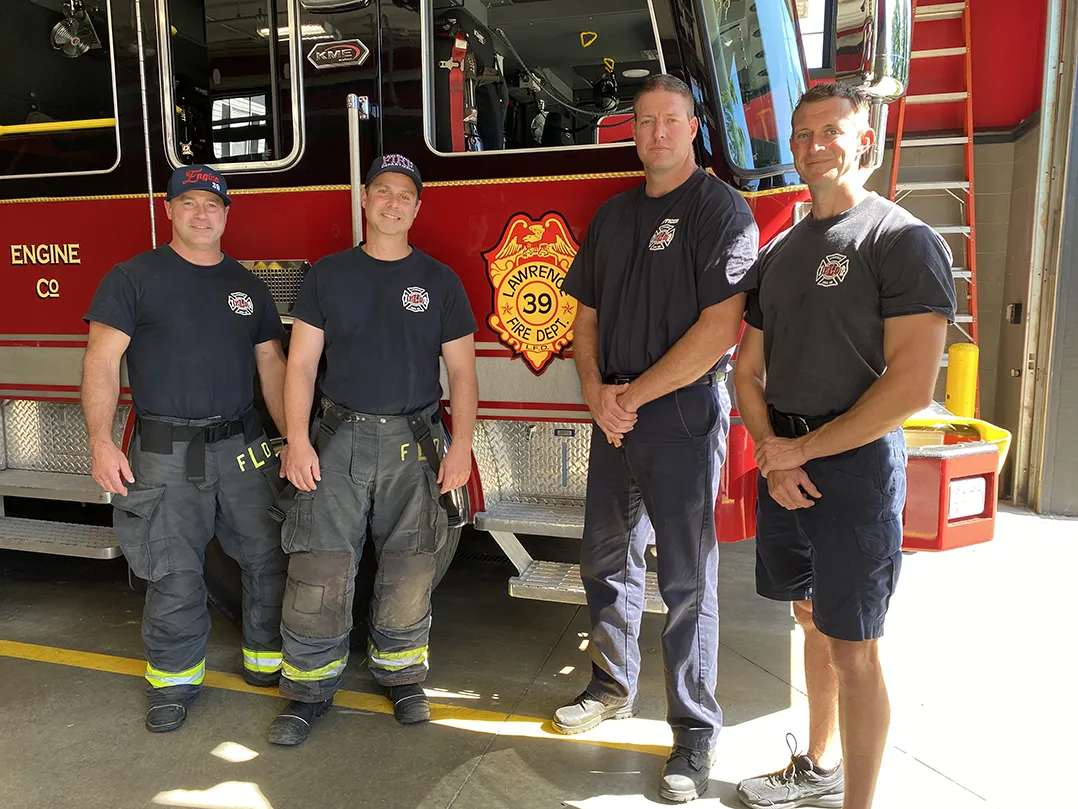Communities rely on firefighters to respond when there’s an emergency. To do that, firefighters need reliable equipment. Lawrence Fire Department Station 39 on Richart Avenue recently upgraded one of its most important pieces of equipment with a new fire engine.
After returning from an emergency call on a hot June afternoon, LFD Capt. Adam Reine sat down to talk about the new engine and the years-long process to acquire it before the completed apparatus was delivered earlier this spring.
It all started with an apparatus spec committee, he said, which comprised captains and firefighters.
“The purpose of the apparatus spec committee was to basically do some homework,” he said. For example — going to the department’s head of maintenance to find out what kind of engine would work best. “From a mechanical standpoint, what do you like to see on the engine or the apparatus? And he would go into, ‘Well, I want the big block. We need the bigger size engine. It’s more robust. It’s going to handle the wear and tear better. We want the larger transmission, because it’s going to handle the wear and tear better.”
The committee also talked to firefighters to find out their preferences, Reine said, starting with the must-haves before considering nice-to-haves. There are lots of options when ordering a new fire engine, including different kinds of doors for the equipment storage hatches.
“Then the list was drawn up — these are the things that we want,” he said, adding that the result will never be perfect from any one person’s perspective. “As with any business, somebody can say we want this, and the committee — we have to vote on it. Maybe 40 percent are going to be like, ‘Well, I think we should have done it this way.’ But in the grand scheme of things, that committee was formed to hopefully better standardize and help with the process of how we spec our engines out.”
Once the spec list is complete and approved by the fire chief, Reine said, committee members check out two or three manufacturers, meet with sales teams and start negotiating a design. That part of the process started in February 2021 — the tail end of the COVID-19 pandemic, during which there were many supply-chain delays that continue to affect certain industries, including emergency response vehicle manufacturing.
When the new engine arrived this spring — three years later — it was fully customized to fit the needs of the firefighters who operate it. Reine said one of those features is a 500-gallon water tank, which allows firefighters to get water onto a blaze right away while other responders hook hoses up to a hydrant for continued water flow. That much water on a truck also is useful in rural areas without nearby hydrants.
“Also, on the interstate — car fires — you can lack hydrants there,” he said.
Fun fact — those seemingly random doors in walls along highways contain fire hydrants, Reine said, so while water might not be easily accessed from a response site, it is available.

Some other features on the new engine include roll-up doors for storage hatches to reduce the footprint when the engine is parked during a response; ladders on the exterior of the truck rather than tucked inside where they can accumulate dirt; and angles cut to the tailboard to reduce the likelihood of firefighters whacking their shins on a sharp corner.
Engine 39 was dedicated during a May 10 ceremony at the station, during which LFD Chief Bob Wallace thanked everyone who worked to get the new engine, including all the firefighters who will use it daily.
“Even though this is a brand-new engine, where the real rubber meets the road is you guys — the firefighters,” he said. “If it wasn’t for your dedication, professionalism, courage, none of this stuff actually really matters. It’s you guys that make the difference and I appreciate it.”
Reine said Station 39 averages about eight runs a day. He appreciates that the city ensures its firefighters have new, reliable equipment so he and other first responders can do their jobs.
“No matter what, we’re going to go on the fire, we’re going to go on the call and we get the job done,” he said. “Having a new engine gives us the ability to go out there and do that and it keeps us safe.”

Replacement rotation
The City of Lawrence aims to replace fire engines at all its stations after seven years of service, LFD Capt. Adam Reine said, noting that while each apparatus averages about 25,000 miles a year, they are hard miles.
“It’s hard on the brakes, it’s hard on the trucks,” he said. “So, every seven years, this current administration and the last administration, it was their goal to always make sure we’re in new apparatus that is safe. As apparatus ages, things start to deteriorate.”
It takes two to three years to receive a new engine after ordering one, though, so even though Station 39 just got a new $650,000 engine, the replacement process most likely will start again in 2028 or 2029.
When the next new engine arrives sometime in 2031, the current one will go into reserve status — still usable and available in case of an emergency.




